Students require technology that meets their every need, whether they’re in class or working remotely from home. As more and more tasks demand their time, the best Chromebooks for students can definitely rise to the challenge. They’re lightweight, often light on the wallet, and even support both Android and Linux, making them a solid choice for college students as well students of other kinds.The Asus Chromebook Flip C214 is our current top pick for the best Chromebook for students, rising above the competition for its overall success in all our tests. But there are some alternatives worth checking out. Here’s everything you need to know.
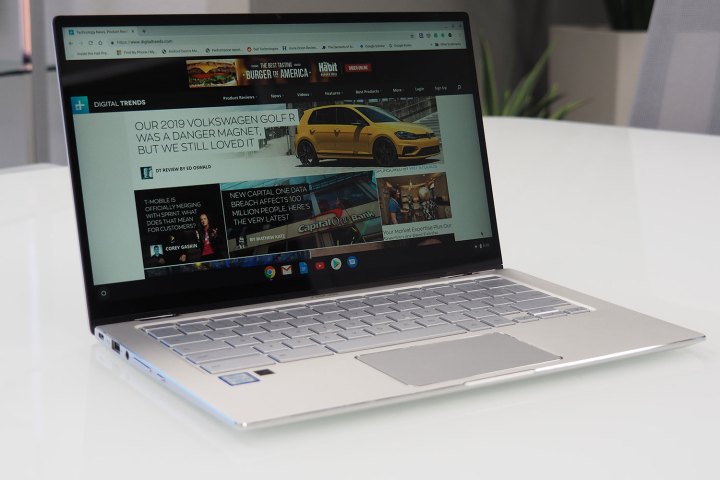
Mark Coppock/Digital Trends
Asus Chromebook Flip C434
Pros
- Lightweight 2-in-1 desgin
- Long battery life
- Ruggedized construction
Cons
- May not have enough power for higher-level tasks
Why you should buy this: Offering military-grade durability, long battery life, and an included stylus, it’s the best Chromebook option for students.
Who it’s for: Students who want an exceptional rugged notebook at an exceptional price.
Why we picked the Asus Chromebook Flip 434:
The Chromebook Flip is a well-rounded 2-in-1 laptop option for students who want to save money while benefiting from a durable, all-aluminum laptop that can keep up with school tasks. At under 3 pounds, it makes a great pairing with the Asus stylus, which allows students to sketch or annotate on the go. We also like the keyboard layout here, which offers a 1.4mm key travel distance and a touchpad with “palm rejection” to stop from accidentally moving the cursor.
This Flip is powered by an Intel Core m3-8100Y dual-core processor backed by either 4GB or 8GB of memory, enough to browse the web, manage word processing, and get work done. The 14-inch screen offers Full HD resolution and a 360-degree hinge for whatever angle you would prefer.

Asus Chromebook Flip C434
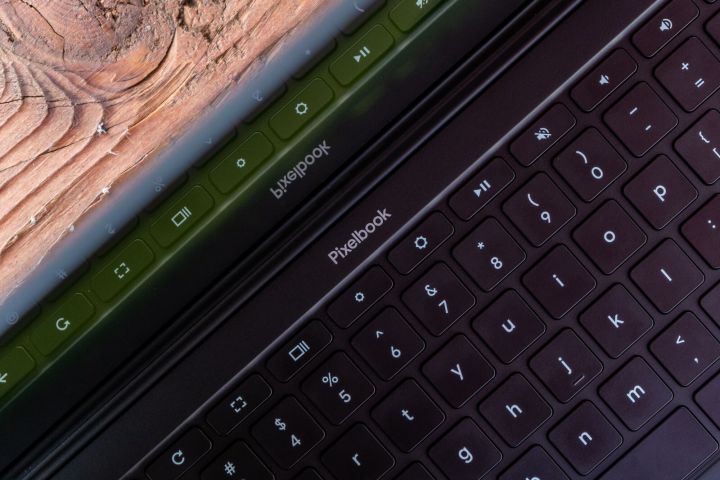
Riley Young / Digital Trends
Google Pixelbook Go
Pros
- Portable design
- Bright, colorful display
- Speakers are impressive
- Excellent battery life
Cons
- Chunky bezels
- No fingerprint scanner
Why you should buy this: Despite its high cost, the Pixelbook Go is one of the best Chromebooks you can buy, making it great for everyone, not just students.
Who it’s for: Anyone who wants one of the best Chromebooks on the market, including students who demand high performance.
Why we picked the Google Pixelbook Go:
Google’s Pixelbook Go is one of the best Chromebooks students can purchase right now, but it’s a bit more expensive than our top pick. Featuring a 13-inch Full HD display, the screen offers plenty of room for students to manage multiple windows side-by-side, such as researching and writing up an essay.
Computing power won’t be lacking, either, thanks to the inclusion of an Intel Core m3 processor on the base model. The CPU selection maxes out with an Intel Core i7 processor, which in turn bumps up the display from Full HD to 4K — great for when you want to kick back and relax with Netflix after a long day of classes.
Standout features include a 47-watt-hour battery lasting 12 hours and the ability to fast charge up to two hours in only 20 minutes. If you’re working in a dark lecture hall, the Go’s comfortable backlit keyboard will enable you to continue taking notes without worry. The magnesium finish keeps the Pixelbook light yet sturdy, protecting it as you move between classes.

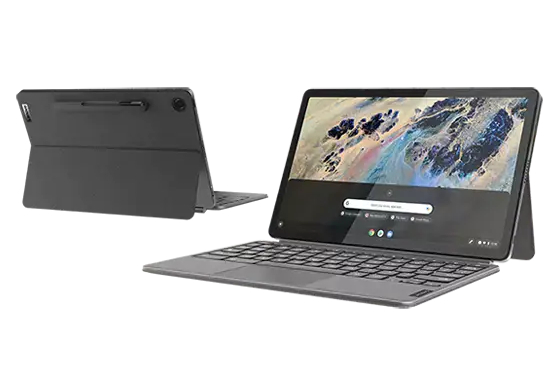
Lenovo IdeaPad Chromebook Duet 3
Pros
- Extra-slim design
- Highly affordable
- USB-C connnections
Cons
- 11-inch screen may be too small for some
Why you should buy this: Lenovo offers a 2-in-1 experience that is both functional and affordable. Plus, it includes all the accessories.
Who it’s for: Students who need an affordable Chromebook for both school and leisure time.
Why we picked the Lenovo IdeaPad Duet:
Even with more premium Chromebooks now on the market, there are still a few great budget laptop options. While many are mediocre, the Lenovo IdeaPad Duet 3 meets all the criteria. It’s a 2-in-1 Chromebook complete with a detachable keyboard and an updated 11-inch display that packs in a 2K resolution.
Other upgrades benefits include Bluetooth 5.1 and a USB-C port for your latest connections, plus 4GB of RAM and 64GB of eMMC storage. The keyboard is a little cramped if you don’t have a lot of experience with 2-in-1 keyboards, but it doesn’t take long to get adjusted. The screen also has full USI 2.0 stylus support, although that’s not included in the box. There are models that increase the storage, but one of our favorite features of the Duet is how affordable it is, so we suggest sticking with the 64Gb model and possibly adding an external hard drive if you need it.

Lenovo IdeaPad Chromebook Duet 3
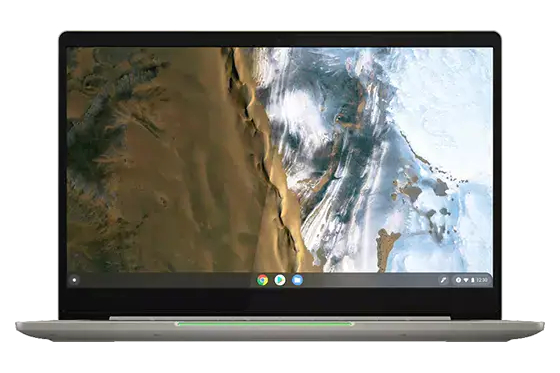
Lenovo Chromebook 5i
Pros
- Larger display than many Chromebooks offer
- 10-hour battery life
- 256GB SSD
Cons
- Other non-Chromebook laptops can offer larger displays
Why you should buy this: Lenovo’s Chromebook 5i offers a larger 14-inch touch-enabled display that outshines other Chromebooks, providing lots of screen space to get work done.
Who it’s for: Students who need extra screen space to multitask, as well as those who want to kick back with Netflix after a long day.
Why we picked the Lenovo Chromebook 5i:
Lenovo offers a Chromebook aimed squarely at the hearts of students seeking larger displays and to binge-watch shows. The 14-inch FHD touchscreen allows for students to multitask with ease, opening more windows than a smaller screen might allow. Need to work on an essay in Google Docs or reference a notes app? No problem! Best of all, despite the large display, the 5i still pulls in an impressive 10 hours of battery life.
Under the hood, the Chromebook 5i features an 11th-gen Intel Core i5 processor and 4GB of RAM, making it one of the more capable Chromebooks on our list. It also comes with 256GB of solid-state drive storage, along with two USB-C ports and Wi-Fi 6 support. If you don’t mind hauling a little extra weight between classes, this Chromebook is an efficient compromise between traditional laptop features and the lightweight, affordable Chrome features.

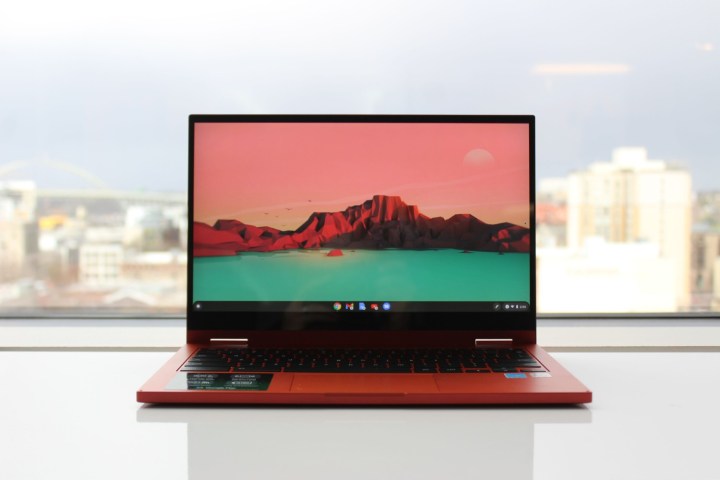
Samsung Galaxy Chromebook (2020)
Pros
- AMOLED display
- 8GB of RAM
- UHD resolution
Cons
- A little expensive compared to many Chromebooks
Why you should buy this: It’s an upgraded Chromebook with an incredible UHD AMOLED display.
Who it’s for: Students who want a superior display for design work as well as entertainment.
Why we picked the Samsung Galaxy Chromebook (2020):
Students may be interested in an upgraded Chromebook display, which can be helpful for design and photography as well as enjoying entertainment with a higher-quality image. If that’s the case, this Samsung Galaxy Chromebook is the perfect choice with its 13.3-inch, UHD AMOLED screen, a combination that guarantees one of the best images possible on a laptop.
It’s also significantly advanced in other specs, such as the 8GB of RAM and 256GB of SSD storage — more than many Chromebooks offer. The 2-in-1 design also allows for easier sketching and a variety of positions, depending on what you’re doing. Overall, if you really like Chrome OS and its speedy operation but want something more like a traditional laptop with a superb screen, the Galaxy Chromebook (2020) is the pick for you.

Samsung Galaxy Chromebook (2020)
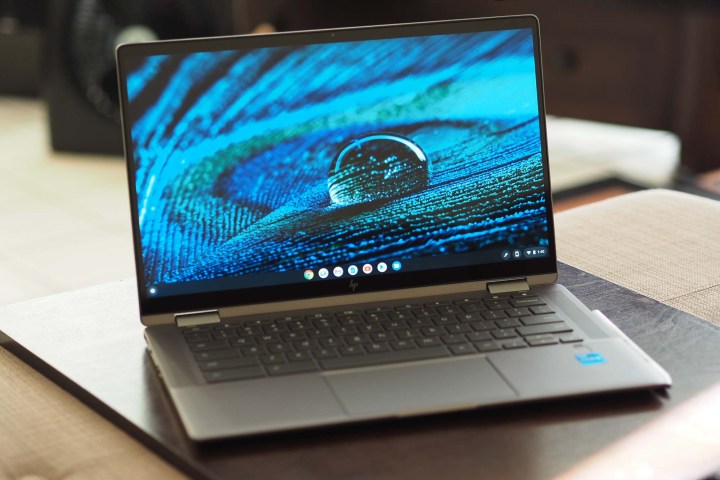
Mark Coppock/Digital Trends
HP Chromebook x360
Pros
- Robust build quality
- Conservative good looks
- Good display
- Excellent touchpad
- Solid productivity performance
Cons
- Disappointing battery life
- Keyboard is a bit too light
- Pen isn’t included
Why you should buy this: HP’s durable design meets Chromebook efficiency.
Who it’s for: Students who want a Chromebook with performance for all kinds of tasks.
Why we picked the HP Chromebook x360:
HP’s latest Chromebook x360 offers a 10th-generation, dual-core Intel Core i3-10110U processor, a 14-inch touchscreen display, and 8GB of RAM. While this model doesn’t come with a built-in fingerprint reader, it does include other advantages of HP’s sturdy design philosophy. This is a laptop that’s ready for work in classrooms and offices, at desks, and any place you may stop in between.
Those looking for updated components will also appreciate the newest additions to the x360, such as support for Wi-Fi 6 and USB-C ports (as well as USB-A and DisplayPort 1.2 connections). Storage is somewhat limited with 64GB eMMC, but fortunately, the included microSD card reader allows for easy expansion if necessary.

Frequently Asked Questions
How do you test Chromebooks?
We carefully research and review notebooks across a variety of platforms, including Windows, MacOS, and Chrome OS. We ensure that each recommended product meets the daily requirements of those who will utilize them. Essential aspects such as battery life, overall performance, portability, and functionality are taken into account to help you select the best option.
Our review process for Chromebooks includes benchmarking the CPU, testing the storage speed and how they perform on the web, and more. We also use them on a daily basis to get a feel for how they perform, just as you would. Does it load apps fast? Do the keys feel great and responsive? Is it heavy and bulky? We live with these machines for weeks so we can make the best recommendations. If we don’t like it, we won’t suggest it no matter how low the price can be.
Should you purchase a Chromebook?
In a world of Windows versus MacOS versus Chrome OS, Chromebooks are seemingly the new kids on the block. The platform is the newest of the three and designed to be lightweight and web-first. Are they good enough to buy? Some students may fall in love, while others may not. Are they right for you? That depends mostly on what you have now and the software you have installed.
While MacOS and Windows are full-featured operating systems, Chromebooks ship with Chrome OS, a platform based on the Chrome web browser. If you can do almost everything you need within Chrome, then a Chromebook will certainly work. If you rely on applications like Adobe Photoshop or iTunes, then a Chromebook shouldn’t be your primary machine.
However, here’s one thing to consider: Modern Chromebooks can run Android applications. Not all Android apps are fully optimized for the screen size or a desktop-style input, however, but in a pinch, they might be able to help you accomplish what you need. Otherwise, you can also check out some of the extensions available in the Chrome Web Store that can expand upon the abilities of your Chromebook.
Most modern Chromebooks now support Linux, too. While still labeled as “beta,” this feature allows Chromebook owners to install traditional Linux software, like GIMP and even Steam. The drawback here is that many student-focused models have very little storage space, so students may be forced to rely on Android apps anyway.
So, in a nutshell, you can run web apps, Android apps, and Linux desktop software on most Chromebooks. You just need to find Linux- and Android-based versions of the programs and apps you use or find close alternatives if you’re planning to run away from Microsoft or Apple.
Editors’ Recommendations





